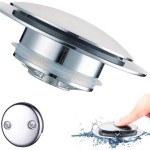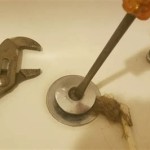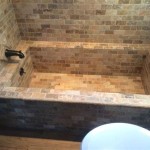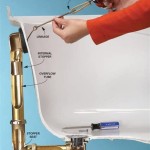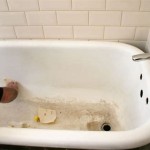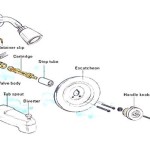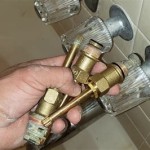Easiest Way To Remove Caulk From A Bathtub
Bathtub caulk, while initially providing a clean, watertight seal, inevitably deteriorates over time. This deterioration can manifest as discoloration, cracking, shrinking, or even the growth of mold and mildew. When caulk reaches this point, it not only diminishes the aesthetic appeal of the bathroom but also compromises its primary function: preventing water from seeping behind the tub and causing potential structural damage. Removing the old, failing caulk is a crucial step in maintaining a healthy and functional bathroom. While it might seem like a daunting task, there are several methods that can simplify the process and ensure a clean and effective removal.
The ease of removing caulk largely depends on its age, type, and how well it initially adhered to the surfaces. Some older caulks become brittle and crumbly, making them relatively easy to dislodge. Others, particularly silicone-based caulks, can be more resilient and require more effort. Choosing the right tools and techniques is essential for minimizing the time and effort required to complete the task. This article outlines practical approaches for removing old caulk from a bathtub, focusing on strategies that prioritize efficiency and effectiveness.
Softening the Caulk: Preparing for Removal
One of the most effective ways to ease caulk removal is to soften it beforehand. This can be accomplished through the application of heat or chemical softening agents. Heat softens the caulk, making it more pliable and easier to cut or scrape away. Chemical softening agents break down the caulk's bonds, weakening its adhesion to the surrounding surfaces. The choice between heat and chemical methods depends on the type of caulk and personal preference. It’s important to remember to always prioritize safety and ventilation when using either of these methods.
Heat Application: Applying heat to the caulk can be achieved using a hairdryer or a heat gun set on a low setting. The goal is to warm the caulk without melting or damaging the surrounding surfaces. Direct the heat along the length of the caulk bead for several minutes, moving slowly and consistently. The heat will cause the caulk to become more flexible, making it easier to cut or peel away. Caution must be exercised when using a heat gun, as excessive heat can damage the bathtub's surface or nearby materials, such as plastic shower surrounds. Always keep the heat gun moving and maintain a safe distance from the caulk.
Chemical Softening Agents: Several commercially available caulk removal products contain chemical solvents designed to break down the bonds of the caulk. These products typically come in gel or spray form. When using a chemical softening agent, carefully follow the manufacturer's instructions. Apply the product liberally to the caulk bead, ensuring that it penetrates the entire thickness of the caulk. Allow the product to dwell for the recommended time, which can range from a few minutes to several hours, depending on the product and the caulk's condition. After the dwell time, the caulk should be significantly softened and easier to remove.
When using chemical softeners, proper ventilation is crucial. Open windows and use a fan to circulate fresh air in the bathroom. Wear gloves and eye protection to prevent skin and eye irritation. Avoid prolonged skin contact with the chemical softener. Also, it's recommended to test the chemical softener on an inconspicuous area of the bathtub surface before applying it to the entire caulk bead to ensure it does not damage the finish.
Utilizing the Right Tools: Cutting and Scraping Techniques
Once the caulk has been softened, the next step involves physically removing it from the bathtub and surrounding surfaces. This is typically achieved through a combination of cutting and scraping techniques. Selecting the appropriate tools for the job is essential for efficient and effective removal without damaging the bathtub. Several specialized caulk removal tools are available, but common household tools can also be used effectively with careful technique.
Caulk Removal Tools: Specialized caulk removal tools often feature a sharp, angled blade designed to slide easily between the caulk and the surrounding surfaces. These tools can be particularly effective for removing silicone caulk, which tends to be more elastic and resistant to scraping. Some caulk removal tools also have a comfortable handle that provides a good grip and reduces hand fatigue. Follow the manufacturer's instructions for using the tool and always exercise caution to avoid damaging the bathtub or surrounding tile.
Utility Knife: A sharp utility knife with a retractable blade can be used to cut along the edges of the caulk bead. Hold the knife at a shallow angle to the bathtub surface and carefully slice along the top and bottom edges of the caulk. Make multiple shallow passes rather than trying to cut through the caulk in one attempt. This technique minimizes the risk of damaging the bathtub. Use a fresh, sharp blade to ensure clean cuts and reduce the amount of force required. Always retract the blade when the knife is not in use for safety.
Putty Knife or Scraper: A putty knife or scraper can be used to pry the caulk away from the bathtub and surrounding surfaces. Choose a putty knife with a thin, flexible blade. Insert the blade between the caulk and the surface and gently pry the caulk away. Work slowly and carefully, avoiding excessive force. If the caulk is particularly stubborn, try heating it again or applying more chemical softener. A plastic scraper can be used as an alternative to a metal putty knife to reduce the risk of scratching the bathtub surface.
When using any of these tools, always prioritize safety. Wear gloves to protect your hands from cuts and scrapes. Use eye protection to prevent debris from entering your eyes. Work in a well-lit area to ensure that you can clearly see what you are doing. Dispose of used blades and caulk debris properly to prevent accidents.
Cleaning and Preparation: Ensuring a Proper Seal
After the old caulk has been removed, it is essential to thoroughly clean and prepare the surfaces before applying fresh caulk. Any remaining residue, mold, or mildew can compromise the adhesion of the new caulk and lead to premature failure. This stage is critical for ensuring a long-lasting and watertight seal. Proper cleaning and preparation involve removing debris, disinfecting the area, and drying the surfaces thoroughly.
Removing Debris: Use a scraper, putty knife, or stiff brush to remove any remaining caulk residue from the bathtub and surrounding surfaces. A vacuum cleaner can be used to remove loose debris and dust. Pay close attention to corners and crevices where caulk residue may accumulate. Ensure that all surfaces are clean and free of any loose particles.
Disinfecting the Area: Mold and mildew often grow beneath old caulk, especially in damp environments like bathrooms. Disinfecting the area is essential to prevent the recurrence of mold and mildew after the new caulk is applied. Use a solution of bleach and water (approximately 1 part bleach to 10 parts water) to disinfect the surfaces. Apply the solution to the affected areas and allow it to dwell for several minutes. Rinse thoroughly with clean water.
Drying the Surfaces: Before applying new caulk, the surfaces must be completely dry. Use a clean cloth or paper towels to dry the bathtub and surrounding areas. A hairdryer set on a low setting can be used to speed up the drying process. Ensure that all moisture is removed, especially from corners and crevices. Applying caulk to a damp surface can prevent proper adhesion and lead to premature failure.
In addition to cleaning and drying, consider using a caulk primer to improve adhesion. A caulk primer is a specialized product that is applied to the surfaces before caulking to enhance the bond between the caulk and the surface. Follow the manufacturer's instructions for applying the caulk primer. Allow the primer to dry completely before applying the new caulk.
By following these steps for softening, removing, cleaning, and preparing, individuals can efficiently and effectively remove old caulk from a bathtub and ensure a proper seal with the new application. This meticulous approach not only enhances the aesthetic appeal of the bathroom but also safeguards against potential water damage and promotes a healthier indoor environment.

How To Remove Old Caulk Dap Global

How To Remove Caulk From Tub Diy Family Handyman

How To Remove Caulk Ace Hardware

Stop Water Damage Re Caulk Your Tub Today 1 Tom Plumber

How To Easily Remove Bathroom Caulk Re Shower And Tub

Here S How Remove And Replace Mildewed Bathroom Caulk

Caulk Remover How To Remove Old

How To Remove And Replace Old Caulk Re A Bathtub

How To Remove Silicone Sealant Diy Guide Removing Old Beginners Removal

How To Remove And Replace Your Tub Shower Caulk Anderson Lumber
Related Posts

